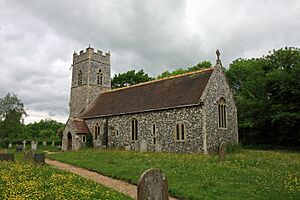Arminghall facts for kids
Quick facts for kids Arminghall |
|
|---|---|
 St Mary's Church |
|
| Civil parish |
|
| District |
|
| Shire county | |
| Region | |
| Country | England |
| Sovereign state | United Kingdom |
| Post town | Norwich |
| Postcode district | NR14 |
| Dialling code | 01508 |
| EU Parliament | East of England |
| UK Parliament |
|
Arminghall is a small village in the county of Norfolk, England. It is found about 3 kilometers (2 miles) southeast of the city of Norwich. Most of the homes in Arminghall are near the local church. A company that makes electronic parts, Syfer Technology, is also located here. In 1931, about 108 people lived in the village.
Contents
History of Arminghall
The name 'Arminghall' means 'Nook of land of Ambre's/Eanmaer's people'. This suggests it was once a special place for a group of people. Arminghall was first written about in the Domesday Book. This was a very old survey of England made in 1086.
The village used to be its own civil parish. A civil parish is a small local area with its own council. But on April 1, 1935, Arminghall joined with a nearby parish called Bixley. Later, in 2019, Bixley parish also changed. It became part of a new parish called "Caistor St Edmund and Bixley."
The Amazing Arminghall Henge
One of the most exciting things about Arminghall is a very old site called the Arminghall Henge. It is a prehistoric timber circle and henge monument. This means it was a large, circular area with wooden posts and ditches.
How the Henge Was Found
The henge was discovered in 1929 by a brave man named Gilbert Insall. He was flying over the area in a plane. He was taking air photos to find new archaeological sites. From about 600 meters (2,000 feet) up, he saw strange patterns in the fields. These patterns are called cropmarks. They show up when plants grow differently over buried structures.
He saw a circular shape made of two rings. Inside, there was a horseshoe shape with eight pit-like marks. The whole site was about 75 meters (246 feet) across.
Exploring the Henge
A week later, another expert, O.G.S. Crawford, visited the site. He called it the Norwich Woodhenge. It wasn't until 1935 that the site was dug up for the first time. This work was done by an archaeologist named Grahame Clark.
Clark's team found that the two circular rings were actually ditches. The outer ditch was about 1.5 meters (5 feet) deep. The inner ditch was even deeper, about 2.3 meters (7.5 feet) deep. They also found signs that a bank of earth once stood between these ditches.
The pits in the middle were postholes. These were holes where huge wooden timbers once stood. These timbers would have been almost 1 meter (3 feet) wide!
When Was It Built?
The Arminghall Henge dates back to the Neolithic period. This was a very old time in history, often called the New Stone Age. Scientists used a method called radiocarbon dating on charcoal found in the post-pits. They found that the henge was built between 3650 and 2650 BC. That's over 4,000 years ago!
The henge was built in a special way. It lines up with the mid-winter sunset. When you stand at the henge, you can see the sun set down the slope of a nearby hill called Chapel Hill. This suggests it might have been used for special ceremonies or to track the seasons.


